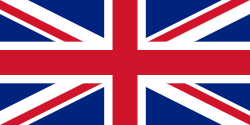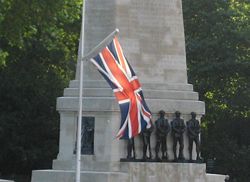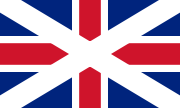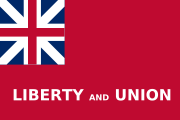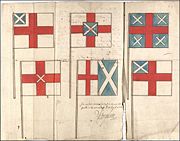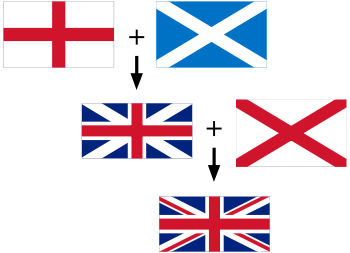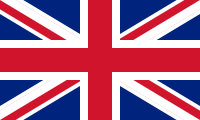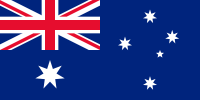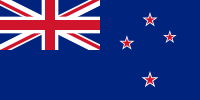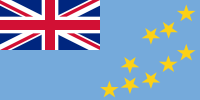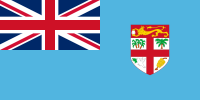Union Flag
2008/9 Schools Wikipedia Selection. Related subjects: Geography
The Union Flag, also known as the Union Jack, is the national flag of the United Kingdom of Great Britain and Northern Ireland. Historically, the flag was used throughout the former British Empire. It retains an official or semi-official status in many Commonwealth Realms. The current design dates from the Union of Great Britain and Ireland in 1801.
Terminology
It is often stated that the Union Flag should only be described as the Union Jack when flown in the bows of a warship, but this is a relatively recent idea. From early in its life the Admiralty itself frequently referred to the flag as the Union Jack, whatever its use, and in 1902 an Admiralty Circular announced that Their Lordships had decided that either name could be used officially. Such use was given Parliamentary approval in 1908 when it was stated that "the Union Jack should be regarded as the National flag".
Whether to use "Union Flag" or "Union Jack" is a matter of debate. One view is that "Union Jack" should be used only for the flag when it is flown as a jack (a small flag flown at the bow of a ship), but it is not universally accepted that the "Jack" of "Union Jack" is a reference to such a jack flag and is only an educated guess.
The Flag Institute, the vexillological organisation for the United Kingdom, stated that the term Union Flag is a "relatively recent idea". It also noted that "From early in its life the Admiralty itself frequently referred to the flag as the Union Jack, whatever its use, and in 1902 an Admiralty Circular announced that Their Lordships had decided that either name could be used officially. Such use was given Parliamentary approval in 1908 when it was stated that "the Union Jack should be regarded as the National flag". Nevertheless, the term "Union Flag" is used in King James's proclamations of 1606 and 1634, and in King George III's proclamation of 1 January 1801 concerning the arms and flag of the United Kingdom of Great Britain and Ireland.
When the first flag was introduced in 1606, it became known simply as "the British flag" or "the flag of Britain", although the royal proclamation had called it "the Union Flag". The word 'jack' was in use before 1600 to describe the maritime bow flag. By 1627 a small Union Jack was commonly flown in this position. One theory goes that for some years it would have been called just "the Jack", or "Jack flag", or "the King's Jack", but by 1674, while formally referred to as "His Majesty's Jack", it was commonly called the Union Jack, and this was officially acknowledged.
The size and power of the Royal Navy internationally at the time could also explain why the flag was named the "Union Jack"; considering the navy was so widely utilised and renowned by the United Kingdom and Commonwealth countries, it is possible that the term "Jack" did occur because of its regular use on all British ships using the "Jack Staff" (a flag pole attached to the bow of a ship). Even if the term "Union Jack" does derive from the jack flag (as perhaps seems most likely), after three centuries, it is now sanctioned by use, has appeared in official use, and remains the popular term.
The BBC website does not use the term "union flag" because of its "great potential for confusion", preferring union jack (in lower case). The Merchant Shipping Act 1995 refers to the national colours of the United Kingdom as "the Union flag (commonly known as the Union Jack) …".
The term "Union Flag" is less well-known outside the United Kingdom, and may refer to other union flags.
History
Before 1801
When King James VI of Scotland inherited the throne of England and was crowned James I of England in 1603, the crowns of the Kingdom of England (which since 1535 had included Wales) and the Kingdom of Scotland were united in a personal union through him. Despite this Union of the Crowns, each kingdom remained an independent state.
On 12 April 1606, a new flag to represent this regal union between England and Scotland was specified in a royal decree, according to which the flag of England (also representing Wales by implication), (a red cross with a white background, known as St George's Cross) and the flag of Scotland (a white saltire with a blue background, known as the Saltire or Saint Andrew's Cross) would be "joyned together according to the forme made by our heralds, and sent by Us to our Admerall to be published to our Subjects." This royal flag was at first only for use at sea on civil and military ships of both Scotland and England. In 1634, King Charles I restricted its use restricted to the monarch's ships. Land forces continued to use their respective national banners. After the Acts of Union 1707, the flag gained a regularised status, as "the ensign armorial of the Kingdom of Great Britain", the newly created state. It was then adopted by land forces as well, although the blue field used on land-based versions more closely resembled that of the blue of the flag of Scotland.
Various shades of blue have been used in the Saltire over the years. The ground of the current Union Flag is a deep " navy" blue, ( Pantone 280), which can be traced to the colour used for the Blue Ensign of the Royal Navy's historic "Blue Squadron". (Dark shades of colour were used on maritime flags on the basis of durability). The currently accepted flag of Scotland however uses a lighter " royal" blue, (Pantone 300), following the Scottish Parliament recommendation of 2003.
The blazon for the old flag, to be compared with the current flag, is Azure, the Cross Saltire of St Andrew Argent surmounted by the Cross of St George Gules, fimbriated of the second.
Wales had no explicit recognition in the Union Flag because Wales, having been annexed by Edward I of England in 1282 and following the Laws in Wales Acts 1535–1542, was legally part of the Kingdom of England and was therefore represented by the flag of England. (The present-day Flag of Wales and St David's Cross emerged, or re-emerged, in the 20th century: the former based on the historical emblem of Wales, the Red Dragon, and the latter based on the arms of the Diocese of Saint David's.)
The Kingdom of Ireland, which had existed as a personal union with England since 1541, was likewise unrepresented in the original versions of the Union Flag.
The flag does remain in use, however, appearing in the canton of the Commissioners' Ensign of the Northern Lighthouse Board. This remains the only contemporary official representation of the pre-1801 Union Flag in the United Kingdom and can be seen flying from their George Street headquarters in Edinburgh.
Taunton, Massachusetts, USA, has in recent years used a flag with the old style Union Flag. Likewise, Westmoreland County, Pennsylvania has been known to fly a flag containing the Kings Colours since 1973.
This version of the Union Flag is also shown in the canton of the Grand Union Flag (also known as the Congress flag, the First Navy Ensign, the Cambridge Flag, and the Continental Colours), the first widely used flag of the United States, slowly phased out after 1777.
Other proposed versions
Various other designs for a common flag were drawn up following the union of the two Crowns in 1603, but were rarely, if ever, used. One version showed St George's cross with St Andrew's cross in the canton, and another version placed the two crosses side by side. Also, some Scots were upset that the Scottish flag was underneath the English flag in the version finally adopted, and preferred a version where the Scottish cross was on top (the English flag was placed between the cross of St Andrew and its background).
Since 1801
The current Union Flag dates from 1 January 1801 with the Act of Union 1800, which merged the Kingdom of Ireland and the Kingdom of Great Britain to form the United Kingdom of Great Britain and Ireland. The new design added the red saltire cross of St Patrick's Flag for Ireland. This saltire is overlaid on the saltire of St Andrew, but still beneath the cross of St George. The Irish saltire is arranged counterchange with the saltire of St Andrew, so the white is always on the clockwise side of the red. The arrangement has introduced a requirement to display the flag "the right way up"; see specifications for flag use, below. The additional white stripe is added (as with the St George's cross) to prevent "colour next to colour", a heraldic imperative.
This Saint Patrick's cross is problematic in several ways. Firstly, the symbol does not have much emotional resonance since its history is so thin and hard to find; some believe that it was essentially 'invented' for the purposes of inclusion in the Union Flag. One possible origin is from the arms of the Fitzgerald family ( Dukes of Leinster) who were sent by Henry II of England to aid Anglo-Norman rule in Ireland and has rarely been used as an emblem of Ireland by the Irish; a harp, a Celtic cross, a shamrock, or latterly an Irish tricolour have been more common. However, the exact origin of the flag is unknown, with evidence of saltires being present on ancient Irish coins and maps. The St Patrick's saltire flag has been used in more recent times for St Patrick's Day in Northern Ireland and by both state and civil organisations wishing to avoid the sectarianism that may be implied by the use of either the tricolour or symbols of Unionism, including the recently formed Police Service of Northern Ireland.
The current flag is blazoned Azure, the Crosses Saltire of St Andrew and St Patrick, quarterly per saltire, counterchanged Argent and Gules, the latter fimbriated of the second, surmounted by the Cross of St George of the third, fimbriated as the saltire.
Campaigns for a new Union Flag
In 2003, Nigel Turner started a private campaign – dubbed "reflag" or "union black" – to interpret the Union Flag as racial and introduce black stripes in it; the proposal was rejected as "ridiculous tokenism [that] would do nothing to stamp out racism".
Wrexham’s Labour Member of Parliament (MP) Ian Lucas said, on 27 November 2007 in a House of Commons debate that the Union Flag should be combined with the Welsh flag to reflect Wales’ status within the UK, and that the Red Dragon should be added to the Union Flag's red, white and blue pattern . He said the Union Flag currently only represented the other three UK nations, and Culture minister Margaret Hodge conceded that Mr Lucas had raised a valid point for debate. She said "the Government is keen to make the Union flag a positive symbol of Britishness reflecting the diversity of our country today and encouraging people to take pride in our flag". This development sparked design contests with entries from all over the world; some of the entries incorporated red dragons, St David's Cross and anime characters into the Union Flag.
Status
The Union Flag is used as a jack by commissioned Royal Navy warships, and by certain categories of Army and Royal Air Force vessels, though none are currently (June 2007) in commission. When at anchor or alongside, it is flown from the jackstaff at the prow of the ship. It can only be worn underway when the ship is dressed for a special occasion, or (when flown at masthead) to indicate the presence of an Admiral of the Fleet onboard; including the Lord High Admiral, the British Monarch. It may theoretically be flown to indicate that a court-martial is in progress, though these are normally held in shore establishments.
No law has been passed making the Union Flag the national flag of the United Kingdom: it has become one through usage. Its first recorded recognition as a national flag came in 1908, when it was stated in Parliament that "the Union Jack should be regarded as the National flag". A more categorical statement was made by the Home Secretary in 1933, when he stated that "the Union Jack is the National Flag". But it is still officially a flag of the monarch, rather than the country.
Civilian use is permitted on land, but non-naval/military use at sea is prohibited. Unauthorised use of the flag in the 17th Century to avoid paying harbour duties – a privilege restricted to naval ships – caused James' successor, Charles I, to order that use of the flag on naval vessels be restricted to His Majesty's ships "upon pain of Our high displeasure". It remains a criminal offence under the Merchant Shipping (Registration, etc.) Act 1993 to display the Union Flag (other than the "Pilot Jack" – see below) from a British ship.
The Court of the Lord Lyon, which has criminal jurisdiction in heraldic matters in Scotland, confirms that the Union Flag "is the correct flag for all citizens and corporate bodies of the United Kingdom to fly to demonstrate their loyalty and their nationality."
The Union Flag has been in use in Canada dating back to the British settlement in Nova Scotia in 1621. At the close of the Great Flag Debate of 1964, which resulted in the adoption of the Maple Leaf Flag as the Canadian national flag in 1965, the Parliament of Canada voted to make the Union Flag the symbol of Canada's membership of the Commonwealth and its allegiance to the crown. The move was a concession given to conservatives who preferred to keep the old flag, with its Union Flag in the canton. The Royal Union flag (as it is now known in Canada) is flown alongside the Maple-Leaf Flag on Commonwealth Day and other royal occasions and anniversaries
On 5 February 2008, Conservative MP Andrew Rosindell introduced the 'Union Flag Bill' as a private member's bill as a 10-minute bill in the House of Commons. The Bill seeks to formalise the position of the Union Flag as the national flag of the UK in law, to remove legal obstacles to its regular display and to officially recognise the name 'Union Jack' as having equal status with 'Union Flag'. The bill will receive its second reading on the 17 October 2008.
Other ratios
Although the most common ratio is 1:2, other ratios exist. The British government's flag code book, Flags of All Nations, in section BR20 states that both 1:2 and 3:5 versions are official.
The 3:5 version is most commonly used by the British Army and is sometimes known as the War flag. Note that in this version two of the diagonals of the St Patrick's cross are cut off or truncated.
The Queen's harbourmaster has a Union Flag that is longer than 1:2. The Queen's Colours are almost square and the red and white parts of the diagonal are of equal width. Ship's jacks can be square and have a square Union Flag in the canton.
Use in other flags
Other nations and regions
The Union Flag was found in the canton (upper left-hand quarter) of the flags of many colonies of the UK, while the field (background) of their flags was the colour of the naval ensign flown by the particular Royal Navy squadron that patrolled that region of the world. Nations and colonies which have used the Union Flag at some stage have included Aden, America, Borneo, Ceylon, Cyprus, East Africa (Kenya), Gambia, Gold Coast (Ghana), India, Jamaica, Lagos, Malta, Mauritius, Nigeria, Palestine, Penang (Malaysia), Rhodesia, Sierra Leone, Singapore, Somaliland, Tanganyika and Trinidad. As former British Empire nations were granted independence, these and other versions of the Union Flag were decommissioned. The most recent decommissioning of the Union Flag came on 1 July 1997, when the former Crown Colony of Hong Kong was returned to China.
All administrative regions and territories of the United Kingdom fly the Union Flag in some form, with the exception of Gibraltar (other than the government ensign) and the Crown dependencies. Outside the UK, it is usually part of a special ensign in which the Union Flag is placed in the upper left hand corner of a blue field, with a signifying crest in the bottom right.
Four countries incorporate the Union Flag as part of their national flags: Australia, New Zealand, Tuvalu and Fiji.
In former British colonies, the Union Flag was used semi-interchangeably with territorial flags for significant parts of their early history. This was the case in Canada until the introduction of the Maple Leaf Flag in 1965, but it is still used in the flags of a number of Canadian provinces such as British Columbia, Manitoba and Ontario. Newfoundland and Labrador uses a modified version of the Union Flag, once the flag of the province. Canadian practice allows the Union Flag, known in Canada as the Royal Union Flag, to be flown by private individuals and government agencies to show support for the Monarch and the Commonwealth.
Many other Australian flags retain the use of the Union Flag, including the Royal Australian Navy Ensign (also known as the Australian White Ensign), the Royal Australian Air Force Ensign, the Australian Red Ensign (for use by merchant and private vessels) and the Australian Civil Aviation Ensign. The flags of the six Australian States retain the Union Flag in the canton. The Vice-Regal flags of the State Governors retain the use of the Union Flag. See List of Australian flags for more information.
The Basque Country's flag, the Ikurriña is also loosely based on the Union Flag, reflecting the significant commercial ties between Bilbao and the UK at the time the Ikurriña was designed (1894). The Miskito people sometimes use a similar flag that also incorporates the Union Flag in its canton, due to long periods of contact in the Mosquito Coast.
The jack of the Russian Navy is a common equivalent to the British one with the St George's and St Andrew's crosses reversed in order and colours but unmistakably based on the same design.
The Union Flag was used by the United States in its first flag, the Grand Union Flag. This flag was the same design as the one used by the British East India Company. It also appeared on the South Africa flag as part of a central motif long after the country had gained independence from Great Britain.
Hawaii, a state of the United States, incorporates the Union Flag in its state flag. The canton of the flag reveals the British influence over those islands in the late 19th century. This is the only current use of the Union Flag in any American state flag.
| National and regional flags incorporating the Union Flag |
|---|
| Anguilla · Australia · Bermuda · British Antarctic Territory · British Columbia · British Indian Ocean Territory · British Virgin Islands · Canadian Red Ensign · Cayman Islands · Cook Islands · Falkland Islands · Fiji · Hawaii · Manitoba · Montserrat · New South Wales · New Zealand · Niue · Ontario · Pitcairn Islands · Queensland · Saint Helena · South Australia · South Georgia and the South Sandwich Islands · Tasmania · Tristan da Cunha · Turks and Caicos Islands · Tuvalu · Victoria · Western Australia |
Ensigns
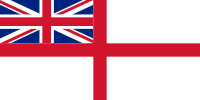
The Union Flag can be found in the canton of several of the ensigns flown by vessels and aircraft of the United Kingdom and its overseas territories. These are used in cases where it is illegal to fly the Union Flag, such as at sea from a British ship. Similar ensigns are used by other countries (such as New Zealand and Australia) with the Union Flag in the canton. Other countries (such as India and Jamaica) follow similar ensign etiquette as the UK, replacing the Union Flag with their own national flag.
Pilot Jack
The flag in a white border occasionally seen on merchant ships was sometimes referred to as the Pilot Jack. It can be traced back to 1823 when it was created as a signal flag, never intended as a civil jack. A book issued to British consuls in 1855 states that the white bordered Union Flag is to be hoisted for a pilot. Although there was some ambiguity regarding the legality of it being flown for any other purpose on civilian vessels, its use as an ensign or jack was established well in advance of the 1864 Act that designated the Red Ensign for merchant shipping. In 1970 the white-bordered Union Flag ceased to be the signal for a pilot, but references to it as national colours were not removed from the current Merchant Shipping Act and it was legally interpreted as a flag that could be flown on a merchant ship, as a jack if desired. This status was confirmed by the Merchant Shipping (Registration, etc.) Act 1993 and the consolidating Merchant Shipping Act 1995 which prohibits the use of any distinctive national colours or those used or resembling flags or pendants on Her Majesty's Ships, except the Red Ensign, the Union Flag with a white border, and some other exceptions permitted elsewhere in the Acts.
Flag days
Canada
In Canada, the Royal Union Flag is flown on specified days from federal buildings, airports, military bases and other government buildings on the following days:
- Second Monday in March ( Commonwealth Day)
- Victoria Day- the official birthday of the monarch (the Monday on or preceding May 24)
- December 11- the anniversary of the proclamation of the Statute of Westminster 1931
The flag is only flown where physical arrangements allow (e.g., when there is more than one flag pole). The flag of Canada is moved to make room for the Royal Union Flag only if the monarch is visiting.
United Kingdom
In July 2007, British prime minister Gordon Brown unveiled plans to have the Union Flag flown more often from government buildings. While consultation on new guidelines is underway, the decision to fly the flag may be made by each government department.
Previously the flag was generally only flown on public buildings on days marking the birthdays of members of the Royal Family, the wedding anniversary of the monarch, Commonwealth Day, Accession Day, Coronation Day, the Queen's Official Birthday, Remembrance Sunday and on the days of the State Opening and prorogation of Parliament. The Union Flag is flown at half mast from the announcement of the death of the Sovereign (save for Proclamation Day), or upon command of the Sovereign.
The current flag days where the Union Flag should be flown from government buildings throughout the UK are:
- 20 January (Birthday of the Countess of Wessex)
- 6 February (Anniversary of the accession of Queen Elizabeth II)
- 19 February (Birthday of the Duke of York)
- Second Sunday in March ( Commonwealth Day)
- 10 March (Birthday of Prince Edward, Earl of Wessex)
- 21 April (Birthday of Queen Elizabeth II)
- 9 May ( Europe Day)
- 2 June (Anniversary of the coronation of Queen Elizabeth II)
- 10 June (Birthday of Prince Philip, Duke of Edinburgh
- June (no fixed date) - Official Birthday of Queen Elizabeth II
- 17 July (Birthday of the the Duchess of Cornwall)
- 15 August (Birthday of the Princess Royal)
- Second Sunday in November ( Remembrance Sunday)
- 14 November (Birthday of the Prince of Wales)
- 20 November (Anniversary of the wedding of Queen Elizabeth II and Prince Philip, Duke of Edinburgh)
In addition, the Union Flag should be flown in the following areas on specified days:
- 1 March (Wales only, for St David's Day)
- 17 March (Northern Ireland only, for St Patrick's Day)
- 23 April (England only, for St George's Day)
- 3 September (Scotland only, for Merchant Navy Day)
- The Day of the Opening of a Session of the Houses of Parliament, Greater London only
- The day of the prorogation of a Session of the Houses of Parliament, Greater London only
On 30 November, ( St Andrew's Day), the Union Flag can be flown in Scotland only where a building has more than one flagpole—on this day the Saltire will not be lowered to make way for the Union Flag if there is only one flagpole. This difference arose after Members of the Scottish Parliament complained that Scotland was the only country in the world that could not fly its national flag on its national day.
Non-government organisations may fly the Union Flag whenever they choose.
Specifications for flag use
The flag does not have reflectional symmetry, due to the slight pinwheeling of St Patrick's cross, which is technically called the counterchange of saltires. Thus, it has a right side and a wrong side up. To fly the flag the correct way up, the broad portion of the white cross of St Andrew should be above the red band of St Patrick (and the thin white portion below) in the upper hoist canton (the corner at the top nearest to the flag-pole), giving the Scottish symbol precedence over the Irish symbol. This is expressed by the phrases wide white top and broad side up. Traditionally, flying a flag upside down is understood as a distress signal. In the case of the Union Flag, the difference is so subtle as to be easily missed by many.
The normal proportions of the flag are 1:2, except in the British Army where a 3:5 version is used. The British Army's flag is the Union Flag, but in 1938 a "British Army Non-Ceremonial Flag" was devised, featuring a Lion on crossed blades with the St Edward's Crown on a red background. This is not the equivalent of the ensigns of the other armed services, but is used at recruiting and military or sporting events, when the Army needs to be identified but the reverence and ceremony due to the regimental flags and the Union Flag would be inappropriate.
The colour specifications for the colours Union Flag (Royal) Blue, Union Flag Red and White are:
| Scheme | Blue | Red | White | General Note: The colour schemes are not all congruent. This is due to different specifications for different types of media (for example, screen and print) * Not official; these are Wikimedia Commons' own conversions of the Pantone. |
|---|---|---|---|---|
| Pantone | 280 C | 186 C | Safe | |
| Web-Safe Hex | #003399 | #CC0000 | #FFFFFF | |
| MoD | 8711D | 8711H | 8711J | |
| NATO | 8305.99.130.4580 | 8305.99.130.4584 | 8305.99.130.4585 | |
| CMYK | 100.72.0.18.5 | 0.91.76.6 | 0.0.0.0 | |
| RGB ( Hex)* | 0, 36, 125 (#00247D) | 207, 20, 43 (#CF142B) | 255, 255, 255 (#FFFFFF) |
Usage and disposal
In general there are no prescriptions regarding the use and disposal of the flag in a manner akin to the United States Flag Code. This reflects its largely unofficial status as a national flag. There is no contemporary national concept of flag desecration. There is also no specific way in which the Union Flag should be folded as there is with the United States Flag. It should just be folded ready for the next use.
Royal Navy Stores Duties Instructions, article 447, dated 26 February 1914, specified that flags condemned for further service use were to be torn up into small pieces and disposed of as rags (ADM 1/8369/56), not to be used for decoration or sold. The exception was flags that had flown in action: these could be framed and kept on board, or transferred to a 'suitable place', such as a museum. (ADM 1/8567/245)
Other names
- In Canada the flag is officially called the Royal Union Flag.
- In China the flag has the nickname Rice-Character Flag (米字旗 pinyin: mǐzìqí) since the pattern looks like the Chinese character for "rice" (米).
- In some countries, including Ireland, the Union flag is sometimes contemptuously termed the Butcher's Apron, because of its perceived association with the killing of civilian populations by English, and later British, forces. In 2006, Sandra White, a Scottish National Party Member of the Scottish Parliament, caused some controversy when she referred to the flag in this way.
